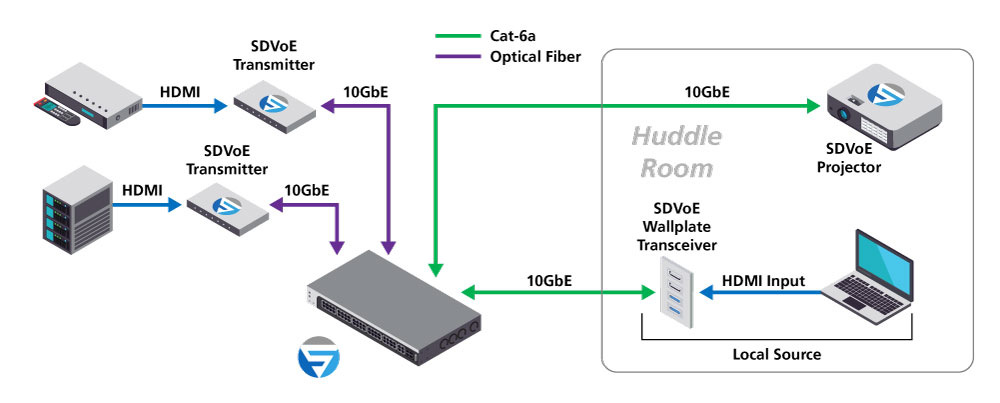用于混合音视频分发的半导体解决方案
BlueRiver® technology uses standard 10 Gigabit Ethernet for both network and point-to-point connectivity since Ethernet was always designed to work this way. Whether a BlueRiver endpoint is connected to an Ethernet switch, or two endpoints connected directly together, it’s 10Gb Ethernet. From the outset, SDVoE™ products have been used for AV networking and point-to-point extension interchangeably. Whether your application requires point-to-point extension of fully featured AV-over-IP, or even a hybrid of the two, BlueRiver-based AV systems can be configured and controlled using the SDVoE Application Programming Interface (API). The SDVoE API standard interface manages switching, configuration and processing with single system-level control for any number of interoperable BlueRiver-based endpoints.
A hybrid AV system is shown in the following diagram, with AV-over-IP being used for the AV distribution core, along with a basic huddle room where only simple point-to-point HDMI extension is required. Note that both local and remote AV sources are available to the huddle room by utilizing an SDVoE wall plate transceiver: HDMI in and HDMI out enabled by one BlueRiver device for bidirectional AV over a single 10G link. Within the huddle room, a simple 2x2 matrix switch with BlueRiver extension is used to switch between local and remote sources to the projector. The SDVoE projector is connected to the AV switch point-to-point using the 10G interface to the BlueRiver based matrix switch. The key here is that all AV endpoints and devices – receivers, transmitter, displays – support SDVoE.

Figure 1. Installations may require a unique approach that utilizes hybrid AV distribution. In this example, the BlueRiver-based matrix switch extension port is connected directly to an SDVoE projector via 10G, providing connectivity for both local and remote sources.
迁移到 AV-over-IP
Since an SDVoE wall plate transceiver was used in the huddle room, the HDMI input can now be used to allow the local source to be connected into the SDVoE network, and the SDVoE projector is simply connected directly to the Ethernet switch, as shown in the diagram below. With an AVP2000-based SDVoE projector, installers can upgrade user software tools to allow multiview modes, such as quad split or picture in picture (PIP), where the projector can show both local and multiple remote sources simultaneously. This approach clearly shows the cost and flexibility benefits of an all IP-based AV system, since less hardware is required in the huddle room and advanced display modes enabled without the need to purchase dedicated multiview processors.
Both local and remote AV sources are fully available in the huddle room, with the flexibility of AV switching via software control, and the number of peripherals required in the room are further reduced (no more 2x2 switch), meaning less equipment to maintain and a better environmental footprint. With all devices SDVoE-enabled, system designers have more flexibility in how to architect an AV install, based on the specific user requirements, whether it be simple, local HDMI extension or flexible and software configurable AV-over-IP.

Figure 2. This AV system takes full advantage of SDVoE, allowing all AV switching over IP, fully controlled via software.
Discover our semiconductor solutions for your Pro AV needs.